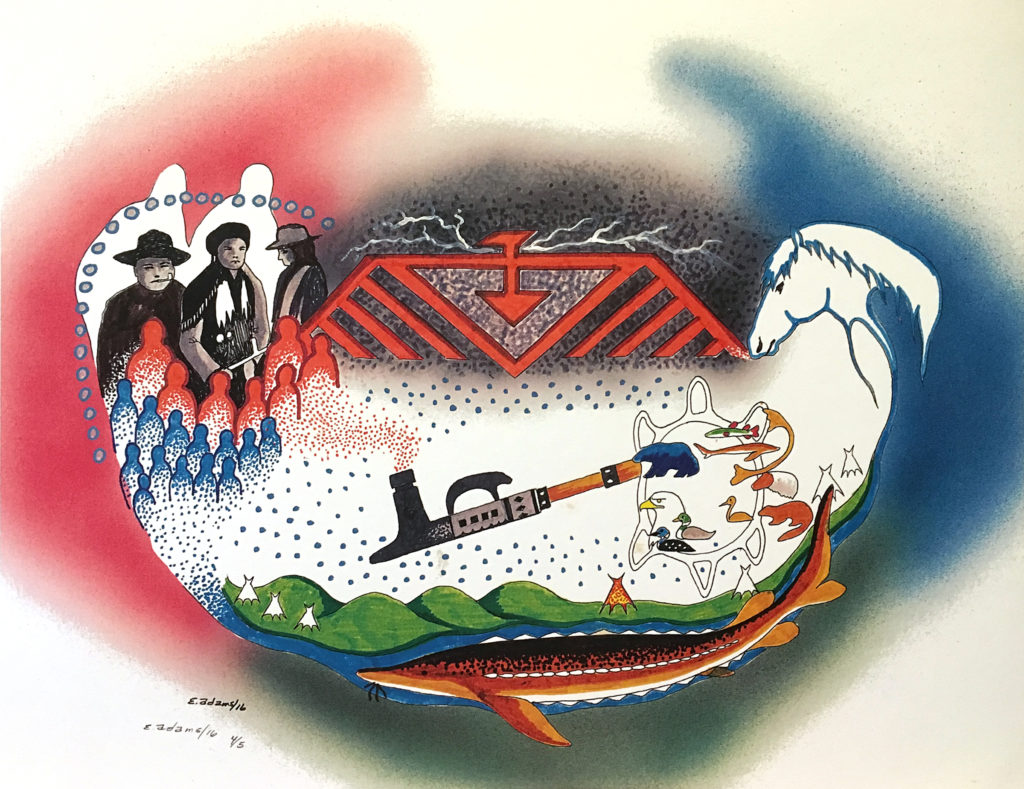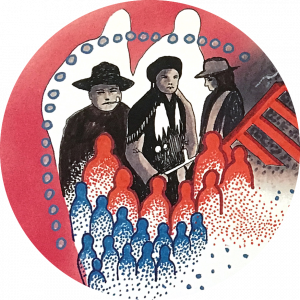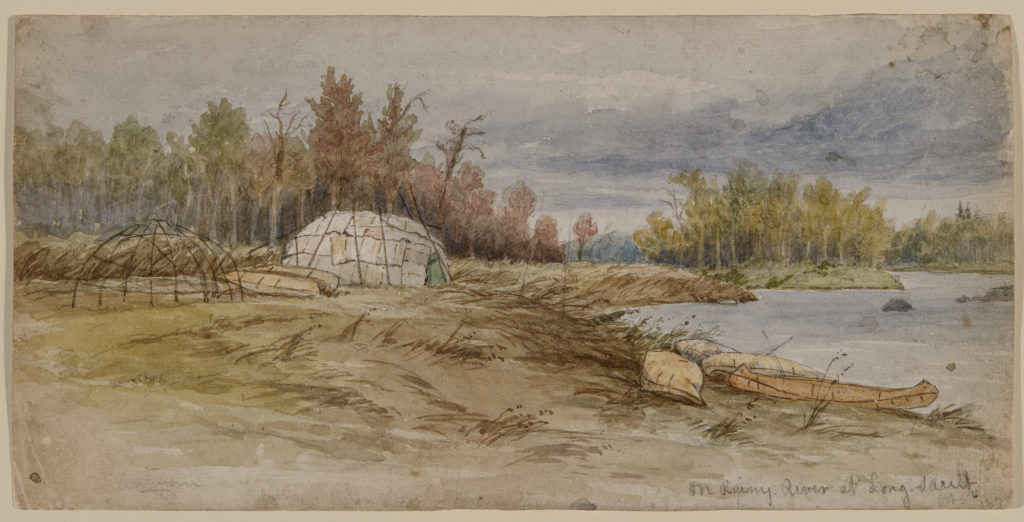Image: Mural by Leo Yerxa at the Kay-Nah-Chi-Wah-Nung Historical Centre. Photograph taken by Christina Pasqua, 2018.
ONE DIARY, MANY STORIES:
VISUAL ART

Elvis Adams
Elvis Adams
is an Ojibwe artist from Big Grassy River First Nation, located on the southeastern shores of Lake of the Woods, who tells stories of Manidoo Ziibi (Rainy River) in his artwork. The Kiinawin Kawindomowin Story Nations project was gifted one of his paintings from the Kay-Nah-Chi-Wah-Nung Historical Centre, along with this narrative about the history of Rainy River First Nations:
“We have always been a Nation: We have carried our own identity, relationship to territory, laws and governance, language, diplomacy and ability to make Treaty. In 1873, the Ojibwe-Anishinaabe Nation entered into a Treaty Agreement with the Crown of England (to which Canada as a Successor State also has obligation to uphold). After four years of meeting (and two years of very intense negotiations), this Agreement was completed on October 3, 1873 near Harrison Creek at the Northwest Angle. In exchange for a variety of Treaty Promises to be upheld, our Nation agreed to allow for access to lands and the sharing of land, place, and space. Land was never given up, sold, or ceded.”
Click on the green tab 1 to view a detailed image of the painting.
This Painting
This Painting
serves to provide an understanding of the history and the formation of Rainy River First Nations, as seen in this painting along the river in yellow 2 . The original seven established reserve community locations are depicted in white 3 along the river, known as Hungry Hall #1 & 2, Wild Lands, Long Sault #12 & 13, and Little Forks.
The three men 4 in clear view represent the three Ogichitaag; Mawidobines (Rainy River), Powassin (Lake of the Woods), and Sakecheway (Lac Seul) who served as negotiators and spokespeople. Mawedobines served the Anishinaabe Nation as the prime spokesperson throughout negotiations. The 24 dots 5 along the side of the three Ogichitaag represent the 24 leaders who were also present and involved with the signing of Treaty #3.

Observing the pipe being lit are two spirits 6 : The Spirit and the Intent of the Treaty. The seven red figures 7 represent the coming leaders in the future, living in the seven locations, who would carry their responsibilities as Anishinaabe in leadership. They are connected to the pipe smoke 8 which is birthed of the sacred fire that was ignited upon lighting of the Opwaagan (Pipe). The blue figures 9 represent the women who (along with men) helped give direction to the leaders of our Nation during treaty negotiations. The women are represented in blue to demonstrate the relationship of Anishinaabe women to the water. Among the signatures on the Treaty, there are no women’s names because although they helped give direction to spokespeople, representatives of the Crown would not meet with them.
The small dots 10 reaching from afar represent the 1400 Anishinaabeg present at the signing of Treaty 3. The Opwaagan (Pipe) 11 is central to the painting, just as it is central to our Treaty. The pipe establishes the creation of our laws and grounds them in spiritual responsibility and accountability. The Opwaagan shown is the one used during our Treaty. This Treaty became law the moment the Opwaagan was lit.

Central to our Nationhood is the Anishinaabe Clan system. There are seven original Clans of the Anishinaabeg to which the numerous Clans today are relatives. To the right of the painting is an image that depicts the nine Clans 12 associated with Anishinaabeg connected to the seven established communities.
The Sturgeon 13 represents a spirit, a being, a source of food, and a source of self-reliance for Anishinaabeg to which we have had a relationship since time immemorial. The Horse Spirit 14 is said to be the guardian of the Rainy River First Nations. Binesi 15 , the thunderbird, is a powerful symbol which has a relationship to our Anishinaabe Nation. It can be seen high above the river in the painting. It is one of the only spirits that has both male and female spiritual energy. It carries fire in the form of lightning. It carried water in the form of rain. Evidenced by lightning purifying waters, as well as fire brought to forests which strengthen the indigenous plants, the Thunderbird’s job is restoration: to restore things to how they were intended. The river has a double meaning in this painting. The most obvious is the location of the Manidoo Ziibi or the Rainy River as it is often called today. Also, it serves to hold the memory of the first Treaty made between Indigenous Peoples in Turtle Island and Europe which told of a river of time flowing forever in each direction.
In the sky is the constellation of stars called Bagone-Giizhig (“The Hole in the Sky”) 16 , and it is said the Anishinaabeg were lowered down from here to come into this world. It is included in this painting to remind us of our origins, of Miinigoowiziwin “that which we have been given”, such as our language, original instructions, our Clans, our relationship and connection to the land, our identity, and our ceremonies, and our Inherent Rights and Responsibilities with which we enter this life with Anishinaabeg.
Description of the painting, courtesy of Rainy River First Nations.

Frederick Verner was an artist who accompanied the representatives of the Crown at the negotiations of Treaty 3. His paintings of the Rainy River include this depiction of a wigwam at Long Sault. Courtesy of the National Gallery of Canada.